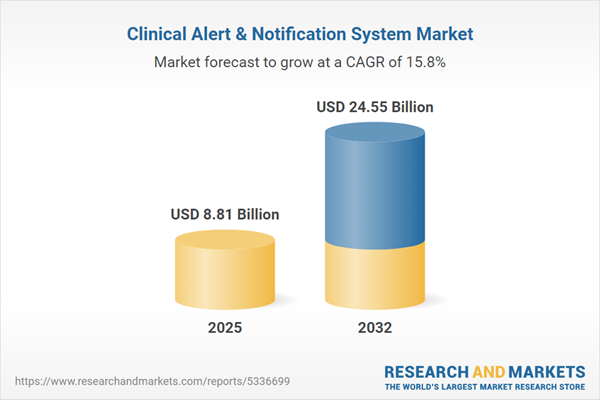Speak directly to the analyst to clarify any post sales queries you may have.
The Clinical Alert & Notification System Market is rapidly transforming healthcare communications, enabling seamless, real-time information delivery across medical settings. Senior decision-makers face new opportunities and challenges in adopting integrated solutions that support operational excellence and improved patient care outcomes.
Market Snapshot: Clinical Alert & Notification System Market Size and Growth Highlights
The Clinical Alert & Notification System Market expanded from USD 7.60 billion in 2024 to USD 8.81 billion in 2025, with continued momentum projected at a CAGR of 15.77%. By 2032, the market is forecast to reach USD 24.55 billion. This robust growth reflects increasing digitization, regulatory influence, and the adoption of advanced technologies within global healthcare infrastructure.
Scope & Segmentation
- Type: Hardware (networking equipment, servers), Services (managed, professional), Software
- End User: Healthcare providers (clinics, hospitals), Patients (caregivers, individual patients)
- Application: Critical alerts (cardiac monitoring alerts, respiratory alerts), Emergency alerts (code blue, evacuation), Routine notifications (appointment and medication reminders)
- Deployment Mode: Cloud (private cloud, public cloud), Hybrid, On-premise
- Regions: Americas (North America, Latin America), Europe, Middle East & Africa, Asia-Pacific
- Key Companies: Spok, TigerConnect, Vocera Communications, Hill-Rom Holdings, Voalte, Imprivata, Amcom Software, Everbridge, OnSolve, Cerner Corporation
Key Technologies Covered
- AI & Advanced Analytics: Leveraging predictive and contextual insights for proactive care management and reduced alert fatigue
- Interoperability Frameworks: Unifying diverse medical devices and health information systems for streamlined data exchange
- IoT Integration: Extending monitoring with wearable sensors and remote data feeds, expanding coverage beyond hospital boundaries
Key Takeaways for Senior Decision-Makers
- Clinical alert systems are transitioning from isolated, manual processes to highly integrated digital platforms. This fosters efficient multidisciplinary collaboration and response agility in both acute and outpatient environments.
- AI-powered analytics filter and escalate critical notifications, empowering care teams to act preventively while minimizing distractions from non-essential alerts.
- Interoperability trends are removing barriers between health record systems and monitoring devices, enabling automated workflows that improve operational effectiveness.
- The proliferation of wearable and IoT-enabled devices drives continuous patient monitoring, enhancing care delivery in both clinical and home settings.
- Ongoing regulatory evolution emphasizes security, privacy, and data compatibility, making compliance and risk management a foundational aspect of system selection and deployment.
Tariff Impact on Clinical Alert & Notification System Market
The 2025 U.S. tariffs introduce new challenges for procurement, cost structures, and supply continuity. Increased import duties on networking hardware and monitoring equipment may prompt organizations to revise technology budgets, delay upgrades, or seek alternative sourcing. Vendors and service providers will likely reassess contracts, opt for regional deployment models, and manage cross-border operations with greater scrutiny. Strategic sourcing, local partnerships, and modular solution designs are essential for mitigating tariff risks and maintaining flexibility.
Methodology & Data Sources
This report bases its findings on primary interviews with hospital CIOs, clinicians, and technology executives, and extensive secondary research including regulatory filings, technical documents, industry white papers, and peer-reviewed publications. Triangulation ensures validity by cross-referencing qualitative and quantitative evidence from credible sources.
Why This Report Matters to Decision-Makers
- Enables informed, strategic investments by detailing technological drivers, regulatory changes, and regional nuances shaping adoption trends.
- Offers actionable recommendations for enhancing alert system performance, ensuring compliance, and sustaining competitive advantage.
Conclusion
Senior leaders seeking to modernize clinical communications can leverage this report’s insights to optimize alert system adoption, navigate market complexities, and accelerate clinical innovation across care environments.
Additional Product Information:
- Purchase of this report includes 1 year online access with quarterly updates.
- This report can be updated on request. Please contact our Customer Experience team using the Ask a Question widget on our website.
Table of Contents
3. Executive Summary
4. Market Overview
7. Cumulative Impact of Artificial Intelligence 2025
Companies Mentioned
The companies profiled in this Clinical Alert & Notification System market report include:- Spok, Inc.
- TigerConnect, Inc.
- Vocera Communications, Inc.
- Hill-Rom Holdings, Inc.
- Voalte, Inc.
- Imprivata, Inc.
- Amcom Software, Inc.
- Everbridge, Inc.
- OnSolve, Inc.
- Cerner Corporation
Table Information
| Report Attribute | Details |
|---|---|
| No. of Pages | 193 |
| Published | October 2025 |
| Forecast Period | 2025 - 2032 |
| Estimated Market Value ( USD | $ 8.81 Billion |
| Forecasted Market Value ( USD | $ 24.55 Billion |
| Compound Annual Growth Rate | 15.7% |
| Regions Covered | Global |
| No. of Companies Mentioned | 11 |









